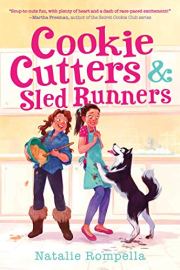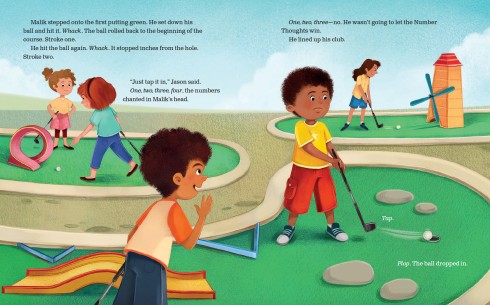by Natalie Rompella
I adore Storystorm month. I have participated for seven years and have over 550 ideas written down. I’m always surprised which Storystorm posts end up sparking the best ideas for me. I am excited to share my own suggestion with you.
Consider brainstorming ideas for stories that deal with social, mental, or physical issues (often referred to as issue or tough-topic books). For examples of tough topics, here is a list from the Association for Library Service to Children.
My first issue picture book, MALIK’S NUMBER THOUGHTS: A STORY ABOUT OCD, came out with Albert Whitman & Co. in September 2022 (illustrated by Alessia Girasole).
 The topic of obsessive-compulsive disorder (OCD) is close to my heart as I have personally dealt with it since seventh grade. In 2009, I wrote a nonfiction book for teens on OCD. I then used my personal experience and the extensive research I had already done to write a novel with a main character who had OCD titled COOKIE CUTTERS & SLED RUNNERS (Sky Pony Press). I was able to really dig into the emotions the character felt, the treatment, and the protagonist’s path to improving her OCD episodes. As well, I got to add in high-interest topics: baking and sled-dog racing.
The topic of obsessive-compulsive disorder (OCD) is close to my heart as I have personally dealt with it since seventh grade. In 2009, I wrote a nonfiction book for teens on OCD. I then used my personal experience and the extensive research I had already done to write a novel with a main character who had OCD titled COOKIE CUTTERS & SLED RUNNERS (Sky Pony Press). I was able to really dig into the emotions the character felt, the treatment, and the protagonist’s path to improving her OCD episodes. As well, I got to add in high-interest topics: baking and sled-dog racing.
But recently I wanted to write a book on OCD for younger children. Writing a picture book on this subject matter was a different ball game:
- My storyline needed to be tighter.
- The wording/medical jargon had to be age-appropriate.
- The scope of what was discussed about the disorder had to be smaller.
- I wanted it to have a fun element that appealed to four- to seven-year olds.
- The story had to show different things happening on each page for engaging illustrations.
I knew from writing my novel that it is difficult to show a character with an undiagnosed problem see a professional, receive a diagnosis, begin treatment, and get to a point that they are temporarily symptom-free/improving. I hadn’t even attempted all of these stages in my novel, and I didn’t feel it would be possible in a picture book. (Note: I was not writing a nonfiction book about OCD where the scope of the disorder was the focus). Instead, I needed to begin the picture book with the character already receiving treatment.
My next thought was how might this disorder interfere with an early-elementary-aged child’s life? Although their schooling may be affected, what other aspects of their life would offer engaging illustrations and be something kids like to do?
I referred to Tara Lazar’s wonderful list of “500 Things That Kids Like.” My thoughts went right to something I loved as a child as do my own children: mini golf.
This topic worked well for my story because the character, Malik, feels the compulsion to do things in sets of four. In mini golf, you want as many hole-in-one scores as you can get. But would his “Number Thoughts” get in the way? And to amp up the tension, I created a friend who is having a party at a mini-golf course, which Malik really wants to attend.

Here are a few tips I learned from writing my issue picture book:
- Brainstorm issue topics that you have encountered in your life: maybe you have personally experienced it, one of your family member or close friend has, or you have dealt with it as a teacher.
- Consider the timeline. Will you focus on a character discovering the issue? Going through treatment? Living with a change? Living with a disorder? Don’t try to do too much. Check out other issue books and study their timeline (it doesn’t have to be the same issue as the book you’re writing about).
- Think about the tone of the book. Play with it. What is your objective for the book? Is your goal to help a child feel less alone? To make the topic less scary? Is there a way to lighten the tone?
- Can you add an engaging setting or activity as part of the storyline? See Tara’s list above.
- Think about ways the issue impacts a child’s life. What are some different aspects that are affected? You may want to address only one. (For instance, I focus on how Malik’s OCD would affect playing mini golf.)
- Avoid overloading the story with facts and information. You can add them in the backmatter.
- Research publishers of issue books. Note the tone of these books and whether it matches the tone you’re using. (When I find a book with a style or topic similar to what I’m writing, I flip to the title or copyright page to find the publisher. The year is also important as approaches change with the times.)
I hope this gives you some ideas for writing a book that shows a character dealing with an issue or tough topic. I have had the pleasure of presenting to a camp for children with OCD. It was very rewarding to hear their reactions to a book that addressed an issue they faced. Hopefully, you can find a topic that you have a strong connection to and create an engaging and helpful picture book for children.
 Natalie Rompella is the author of more than sixty books and other resources for children, including MALIK’S NUMBER THOUGHTS: A STORY ABOUT OCD, a picture book addressing obsessive number thoughts and COOKIE CUTTERS & SLED RUNNERS, a middle grade novel about OCD. She is a former elementary school and middle school teacher. Natalie lives with her two kids, husband, and dog in the Chicago suburbs, where she enjoys playing pickleball, baking, and hanging out with her family. Find out more at NatalieRompella.com or follow her on Twitter @NatalieRompella.
Natalie Rompella is the author of more than sixty books and other resources for children, including MALIK’S NUMBER THOUGHTS: A STORY ABOUT OCD, a picture book addressing obsessive number thoughts and COOKIE CUTTERS & SLED RUNNERS, a middle grade novel about OCD. She is a former elementary school and middle school teacher. Natalie lives with her two kids, husband, and dog in the Chicago suburbs, where she enjoys playing pickleball, baking, and hanging out with her family. Find out more at NatalieRompella.com or follow her on Twitter @NatalieRompella.

Natalie is giving away a copy of MALIK’S NUMBER THOUGHTS: A STORY ABOUT OCD.
You’re eligible to win if you’re a registered Storystorm 2023 participant and you have commented only once on today’s blog post. ↓
Prizes will be distributed at the conclusion of Storystorm.
Source : Storystorm 2023 Day 9: Natalie Rompella Embraces Tough Topics













